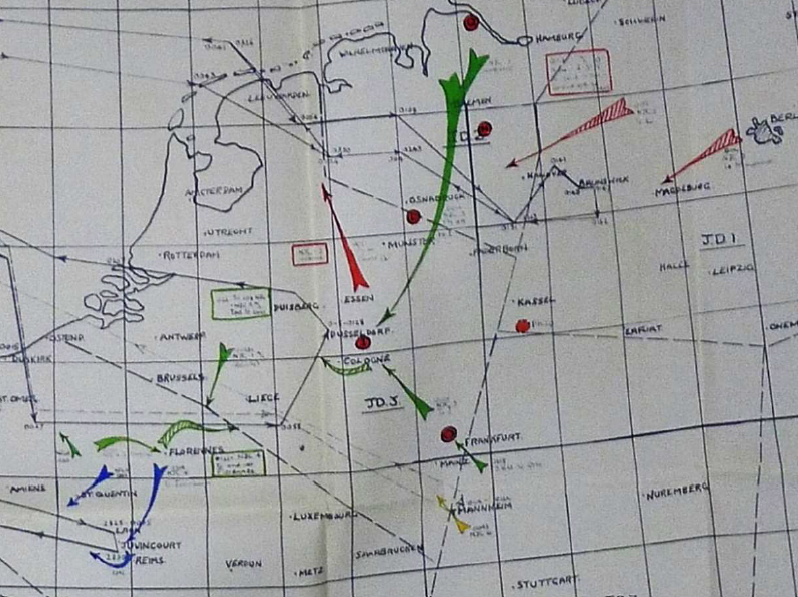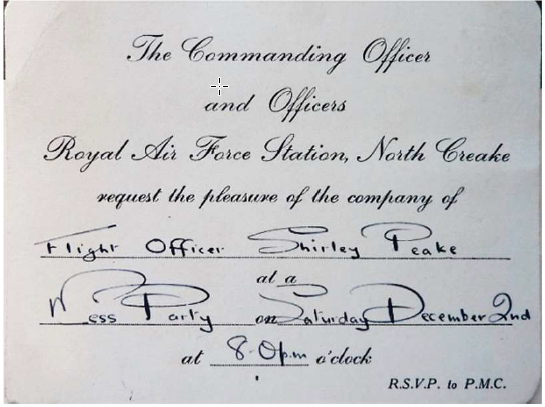In Memoriam - Tribute to Flight Officer Shirley Bellwood (nee Peek)
It was a great pleasure to have become a friend of Flight Officer Peek; a situation that arose very much by chance, although Shirley lived only five miles from my home. We met six years ago and she became a member of the 100 Group Association. Shirley had joined the Women’s Auxiliary Air Force in April 1939 and trained at the Code and Cypher School, Oxford; she was commissioned in January 1941.

Her early operational appointments were at RAF Watton (December 1941 to August 1942; RAF Horsham St Faith (August – October 1942; and RAF Marham (October 1942 to June 1943. Working with the operational stations became very interesting; the aircraft being used were mostly Mosquitoes. Shirley was invited to fly on a practice low-level bombing run, piloted by Group Captain Edwards, VC. That was great fun, but the deadly serious matter was the planning of raids, and the briefing of the crews. This picture (left) was taken at Marham during May 1943.
As Shirley so aptly said, the worst part was waiting for the crews to return and then de-briefing them on their missions. At the end of her appointment to RAF Marham, Shirley was Gazetted on 2 June 1943 with a Mention in Despatches.
Her work from June 1943 onwards at Bomber Command HQ was with the Target Intelligence and Damage Assessment Section, as Intelligence IB, and largely coincided with the full-scale strategic bombing of Germany. This was a particularly challenging period for the Bombing Offensive, both against key targets in the enemy homeland and later in preparations for the Allied landings in Normandy, the latter to deliver the requirements of the Transportation Plan primarily against the railway network that provided the vital logistics support to German forces all along the Channel coast. The scope of the aggregate work was extensive and included the urgent need to establish and maintain a current record of all damage and the effects caused by the bombing raids. These Records formed a reference library that was constantly used by the Intelligence staff to prepare appreciations for use by the Commander in Chief Sir Arthur Harris and the Operational staffs.
Towards the end of this period, the levels of damage and the consequent effects were becoming enormous. Sir Arthur Harris started the production of the Blue Books to supply HM the King, the Prime Minister, President Roosevelt, the Chief of Air Staff and a very small number of other VIPs with up-to-date photographic illustration of the bomb damage being caused. This process used transparent sheets of Kodatrace laid over the individual photographs and hand-marked to show specific damage effects. The Master Set at Bomber Command was used in the Operations Room. Shirley had a hand in assembling these books and quite often delivered the updates directly to Churchill’s official residence at Chequers.
It may have been no chance that Shirley was posted as an Intelligence Officer to 100 Group Headquarters at Bylaugh Hall in April 1944; the Group had just accomplished the initial stages of operations working primarily against enemy night fighters. During April, it was decided to extend the scope of the Bomber Support activities by the inclusion of low level night intrusion using Mosquito aircraft against enemy airfields, taking advantage of the growing Intelligence Section and information from the Y-Service and Bletchley Park. Separately, but most importantly, the Night Hook-Up Service, which linked in real-time the main Signals Intercept stations with Bomber Command Headquarters and Bletchley Park was extended to include 100 Group Headquarters. That Hook-Up Service provided valuable operational information as raids were progressing and helped 100 Group to inflict growing damage on the enemy night fighting system, using the immediate information on the take-off times and movements of the German fighter aircraft. This was high priority material and was passed immediately on the dedicated telephone and teleprinter network. Shirley would have been involved with this activity.
However, this was only the beginning of the crucial operational support by 100 Group to the Main Bombing Offensive by both the Royal Air Force and the US Army Air Force based in the UK. Through the summer and autumn of 1944, the operations by 100 Group Squadrons were heavy and continuous, regardless of the weather which may have prevented operations by the Main Force.
The Intelligence Section also produced Immediate Raid Analysis Reports containing all the available details of the night raids. These typically had ten or more sheets and had to be complete by the next morning, including an appreciation of the effects of the 100 Group activities. The picture (below) is a chart showing the progress of a Main Force raid on the night 22/23rd April 1944. The coloured arrows show the routes of German night fighters in relation to the tracks of the bomber forces.

But life was sometimes fun and this (below) is an invitation to Shirley to attend a Mess Party at RAF North Creake on 2nd December 1944. Shirley stayed at 100 Group HQ until the Group was merged into the new Radio Warfare Establishment that formed at RAF Watton in August 1945. One of her memories of the war was to take a flight in a 105 Sqn Lancaster and to see the destruction of Cologne with just the cathedral standing.

After the war, Shirley studied design and portrait painting at the Chelsea Polytechnic, followed by a job with the Elizabeth Arden organisation, which took her to many locations around southern England, Northern Ireland and Cyprus. A chance encounter led to a job with the make-up department of the BBC – in the early days of television. She worked with the whole series of ‘Maigret’ and did make-up for many other personalities, such as Noel Coward, Sean Connery, Ann Todd, Michael Barry and many others.
I was honoured to represent the 100 Group Association at the Cremation and Wake for Shirley on 28th July 2017. She was a very remarkable lady, and it was a privilege to have known her.
by Wing Commander John Stubbington
This article is from the Autumn 2017 issue of Confound and Destroy